Are you starting your content marketing journey, but not sure of how you should proceed? Or, do you find it difficult to rank on google day by day? Do you find yourself losing your rank on google search engines? Do you think that your content is affected adversely due to recent google search engine updates? And all the while wondering which content marketing SEO strategy is best suited for you?
In this article, we will discuss some important concepts that would get you started. Equipped with these, we will get on to discuss 6 content marketing SEO strategies. Also, we will discuss tips and tricks on how to implement these successfully.
Relationship Between Content Marketers and Google Search Engines
Not in the very distant past, Content Marketing and SEO used to be two different functions. Content Creators used to focus on creating content that their prospects would consume throughout their buying journey. On the other hand, SEO specialists used to focus on optimizing content for search, which would bring visibility to that content. But not anymore!
The silos between content creation and core SEO are getting blurred day by day. This is because Google search algorithms now are putting a huge emphasis on User intent, Quality of content, and the Credibility of the content creator.
With this renewed focus, SEO hacks will tend to become ineffective. More importantly, the relationship between content creators and google search engines will be more inclined towards a meaningful partnership.
How will these changes affect my SEO? Or my content marketing strategy? This article discusses all these aspects in detail, and also lays out specific and actionable strategies that will help content creators rank higher on google searches. Read on!
Key Concepts
What is Content Marketing?
Content Marketing is crafting content to build trust and credibility. This results in your prospect hiring your service or buying your product. Your content marketing SEO strategy should be based on how to provide information that your audience would be interested in consuming. As your prospects consume this information, they start to warm up to you. Such a kind of continual engagement will result in them trusting you, and then buying from you. They would even refer you to their network through social media sharing or word of mouth, resulting in more prospects.
What is SEO?
SEO stands for Search Engine Optimization. Simply stated, SEO is a set of activities and techniques that content creators incorporate. This enables search engine algorithms to get a deeper understanding of your content. This deeper understanding enables google to evaluate the visibility-merit of your content to their users (i.e. to your prospects).
Do Content Marketing and SEO go Hand in Hand?
Yes, Content marketing and SEO go hand in hand. Content marketing is about crafting content that your prospects would find useful. On the other hand, SEO is about getting google to make this useful content visible to your prospects. As content creators, you need to do both – i.e. create content that your prospects will find useful AND at the same time, optimize this content for google search.
As an example, let’s say you have a helpful piece of content that your prospects would be interested in. However, you haven’t optimized it for google search. In this case, google search engine algorithms won’t understand enough what your content is about. As a result, your content would not be visible to your prospects. let’s take the exact opposite case. Let’s say that you have content that is well search optimized, but your content is not so helpful to google search users. Google will notice this user’s disinterest. That piece of content would then fall out of favor with google search engine algorithms. This will result in a loss of visibility to your prospects.
Pay Attention to Content as Well As SEO
To conclude then, in both cases, the result is the same – your content will not be made visible to your prospects. The solution, therefore, is to create meaningful content AS WELL AS optimize it for SEO. You need to do both for your content marketing SEO.
The Content Marketing and Search Engine Partnership Model
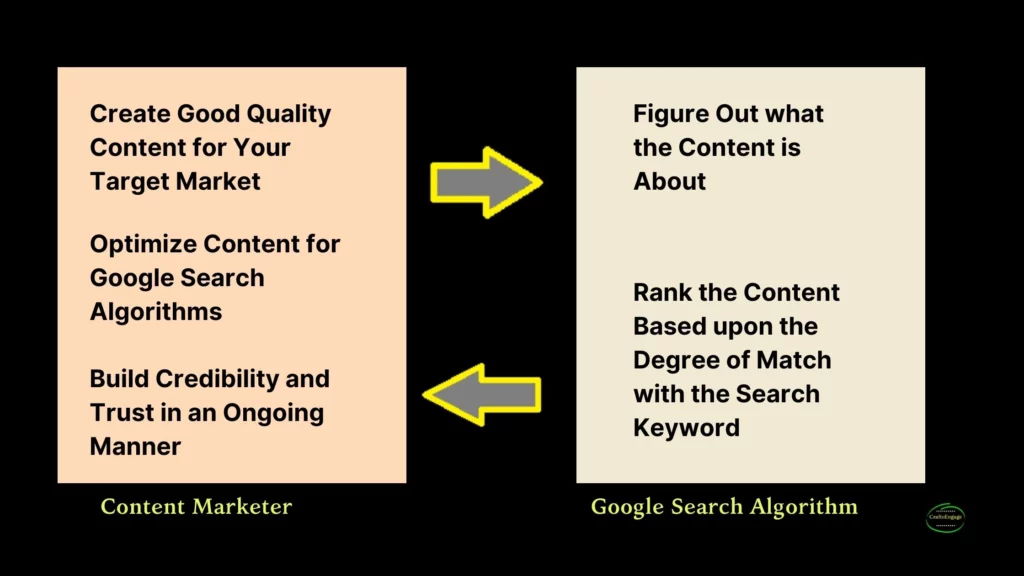
Previously, SEO and content marketing were largely compartmentalized. Google search algorithms were largely focused on figuring out what your content was all about, and then matching it with the search query. On the other hand, content marketers were focusing on creating content that their target audience would find helpful, while also working towards building authority and credibility in the marketplace.
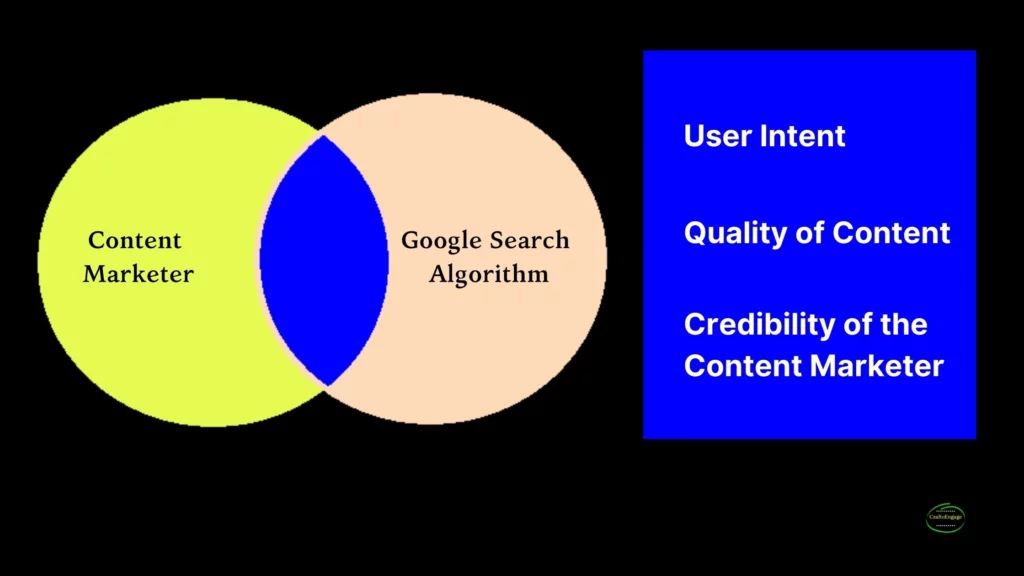
With passing time, Google search algorithms have evolved at a rapid rate. Today, they do way more than match the search query with relevant content. Amongst many other factors, they focus on user intent, Quality of content, and establishing the credibility of the content creator. This makes the decision of your content marketing SEO strategy more involved, as it involves more factors.
This makes the relationship between content marketers and SEO more of a partnership model. Keep this in mind, while deciding upon your content marketing strategy.
It then goes without saying that your content marketing SEO strategy should be based on fulfilling this partnership model.
What is User Intent in SEO?
In the past, Google search algorithms were used to match the search query that the user put in, with the content containing those keywords. However, today’s google algorithms go way beyond this. They now try to understand the INTENTION the user had in their mind in making that query. The matching will be done based on the intention and not solely on the keyword sequence they put in.
What is Buyer’s Journey in SEO?
Buyer’s Journey is a series of stages that your prospect would go through before they purchase on your website. As a content creator, understanding the buyer’s journey of your prospect is crucial. This will play a major decision-making point in choosing the right content marketing SEO strategy. In simple terms, craft content in such a way that all touch-points of the buyer’s journey of your prospect are covered.
This is an example of a typical buyer’s journey

Difference Between User Intent and Buyer’s Journey
In simple terms, User Intent is the cause as identified by google search engines, while the buyer’s journey is the effect. Upon gathering an understanding of the intention behind the query (Called User Intent), google will start showing that content to their users, which could potentially benefit them. Thus, by understanding User Intent, google will enable your prospect to embark upon their Buyer’s Journey. If the information you provide is of interest to your prospects and matches with the User Intent as discovered by google, then google will start ranking your content.
Let’s go over a case study that brings out these elements. Read on.
Case Study to Understand User Intent
Let’s say you want to buy sunscreen. To do that, will you query google for the best sunscreen brands to buy? Not yet!
Firstly, you will try to figure out what factors are to be considered to deciding on a particular sunscreen. In other words, you are in the Broad Awareness stage. Here is a snippet of the first page of the google search engine page for the query – What to look for in a sunscreen.
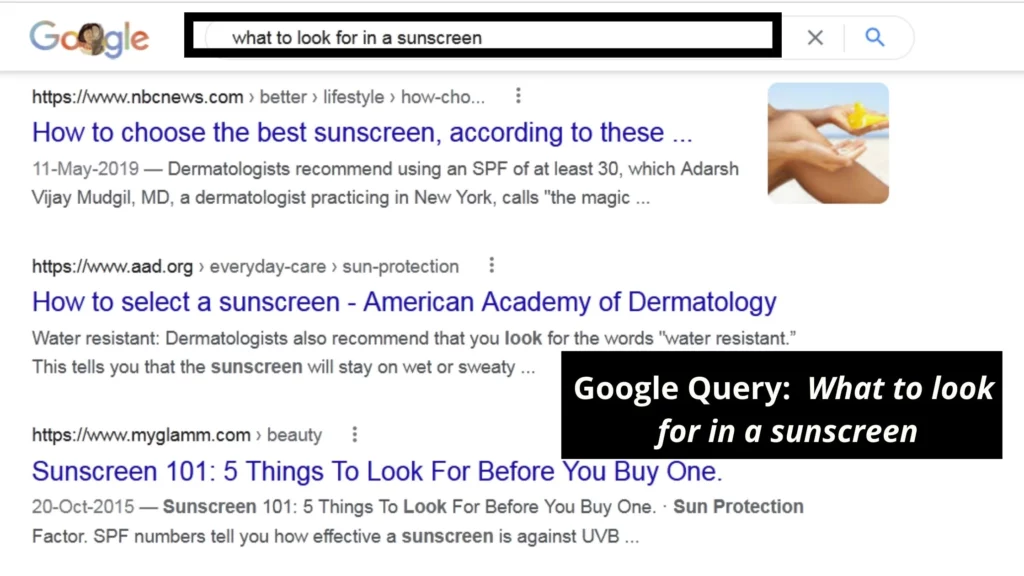
Getting to the Detailed Awareness Phase
As you skim the top articles, you get an overall idea of the factors one needs to consider. However, the more awareness you gather, the more questions you will start to have in your head. Like in this case, you might have questions such as:
- Should I go for natural minerals or chemical-based sunscreen?
- If I go for natural minerals, what should their ideal proportions/percentages be?
- Should I go for the cream version or a spray version of sunscreens? What are the pros and cons for each?
- One of the articles says that FDA has set regulations regarding sunscreens, what might they be?
The above questions will serve as the basis for your second-level queries. You would have never come up with these second-level queries, had you not gone over the results of the first-level ones. These specific question or the likes of it, get you into the Detailed Awareness stage.
Getting to the Comparison and Validation Phase
With that sorted out, some users may want to verify their analysis with what the FDA has to say about choosing sunscreens. These will be the third-level queries. If you have reached this point, you are in the Comparison and Validation stage.
Getting to the Choice Phase
Having had a fair idea of what you should be looking at, the next logical step would be looking for major sunscreen brands and then choosing from them. These would be the 4th-level queries. You are now in the Choice Stage.
Getting the Prospect to the Buy Phase
The last step would be going to the product pages of the chosen brands, comparing them, and then making a purchase. These would be the 5th level queries or the Buy Stage.
| Query Level | User Intent | Example Queries | Buyer’s Journey |
|---|---|---|---|
| 1st Level | How do I start looking for in a sunscreen? What are the factors to be considered |
-What to look for in a sunscreen. -How can you tell if a sunscreen is good. |
Broad Awareness |
| 2nd Level | Need more clarity. I have some questions regarding ingredients, proportions and the like. | -Proportion of minerals in sunscreen -Role of titanium dioxide in sunscreen -Does a sunscreen need zinc and titanium |
Detailed Awareness |
| 3rd Level | Want to validate my analysis with what FDA has to say. | -FDA role sunscreen -What does FDA say about chemical sunscreens |
Consideration |
| 4th Level | Research is complete; now what are my market choices? | -Best sunscreen brands -List of top 10 sunscreens in the market -Best sunscreens for dark skin -Low Price Sunscreens -Best Sunscreen SPF 30 and 50 -Natural Mineral Sunscreens |
Choice and Comparison |
| 5th Level | Ready to buy sunscreen online | -Buy Sunscreen online -Buy Mineral Sunscreen -Buy sunscreen between SPF of 30 and 50 |
Buy |
Table 1: User Intent and Queries
Content Marketing SEO Strategy (List of 6)
Explained below are 6 content marketing SEO strategies that help content creators work in a partnership model with google. Google relies on your content to give its users what they want. Once google links out to your content from their Search Engine Result Page, your prospects would embark on their buyer’s journey. Eventually, they would buy from you and spread the word about your products and services.
The following subsections break down these 6 strategies in more detail.
Content Marketing SEO Strategy #1 – Craft Content that Fulfills User Intent
As the name suggests, this content marketing SEO strategy is about understanding what the user intent of your prospects will be, and then taking them on their buyer’s journey. Following are 4 considerations to keep in mind while implementing this strategy:
1. Base your Keyword Research on your Prospect’s Buyer’s Journey
Try to figure out what set of keywords are readers going to query in their buyer’s journey. Based on this analysis, craft out content that will touch all these points. Make sure that your prospect benefits from this content.
2. Optimize Your Content only for 2-3 Keywords for On Page SEO
Do not optimize your keywords for ALL buyer’s journey keywords. Doing so will make it difficult for google search algorithms to understand exactly what your content is about. Hence, maintain your on-page SEO to only for 2-3 keywords. In other words, your on-page SEO remains unchanged. That said, your content should touch ALL points of the buyer’s journey. This is a smart SEO strategy to get ranked quickly and at the same time, to handhold your reader through their buyer’s journey.
3. Link Out to Credible Sources
Link out to other credible pieces of content on the internet within your article. This will create a seamless reading experience for the user who is on their buyer’s journey. Just make sure that the linking out is in proper context. Google likes you linking out. So, in you doing this, Google will treat your content favorably.
4. Anticipate Questions that Prospects would be Having and Answer them
During the Buyer’s Journey, there will be several questions that your prospect will have in their mind. What if you can proactively provide a brief answer that PRECISELY answers their question? If you can do that, then you have a chance of jumping to the first page of the SERP under the “People also ask:” section. This slot is a relatively low competition slot, so it is worth aiming to get this place. Getting into the answer box propels you to the first page on the Google SERP, without having to compete with well-established brands or other famous or credible domains. Also, you don’t have to compete with paid ads on Google.
How exactly to get there? Firstly, by crafting your content that has a section name that mimics the question your reader might have, and secondly, answer it in one paragraph, within 100-125 words. Aim for as many answer box questions that you think are relevant.
As an exercise, can you figure out where I have aimed for the answer box in this article? Let me know in the comments.
Content Marketing SEO Strategy #2 – Craft Long-Form Content
Textual content that is over 3000 words is considered long-form content. Crafting long-form content is a great way to boost content marketing SEO. A word of caution, though – Understand that you cannot create long-form content on EVERY topic. Never try to fluff out your content to make it seem big. Also, understand that ALL your content cannot be long-form content.
How many pieces of long-form articles do I craft? The next content marketing SEO strategy discusses clustered keywords. Keep reading.
Why Does Long-form Content Do Well?
Following are the reasons:
Higher Engagement
Google loves content that draws engagement. When you craft a piece of long-term content, you are naturally creating a higher possibility that your prospect will get what they are looking for. This creates a higher possibility that your prospects will engage with such content. Google algorithms favor content that draws engagement.
Long-form Content is Treated as More Credible
Google algorithms consider long-term content as more credible. Of course, your long-form content needs to have a low bounce rate and should be well optimized for Google search.
Recent updates in Google search engine algorithms focus on determining the credibility of the content creator.
Possibility of Ranking on More Keywords
When you craft out a long-form article, your on-page SEO is for 2 or 3 keywords. However, with time, you start getting engagement in some sections or subsections. This results in Google promoting your long-form content for other keywords as well. Your content starts to rank faster due to this snowball effect.
Pro- tip: Long-form content takes a long time to rank but fetches a large volume of traffic. Shorter form content ranks faster but fetches relatively less volume traffic. You could combine long-form and shorter form content in a clustered format. This is discussed in detail in Strategy # 3 below.
Long-Form Content Actionables
While crafting a long-form content, take care of the following aspects:
Title it Suitably
Title your long-form content as User guides, Detailed Case Studies, etc. This will attract higher-quality traffic. In other words, when you specify that your article is a user guide for a particular topic, only those interested in a detailed user’s guide will click on your article.
This quality of traffic is far more likely to spend more time reading your long-form content. When Google sees this, it will start ranking it higher. Generally speaking, Google will reward you when you align your goals with Google’s goal, which is to help get the user what they want. This is the true spirit of partnership between content creators and Google.
Link Internally to your Short-Form Content
Back your long-format piece of content with specific content pieces on important subtopics that already exist in your domain. Make sure you send out internal links from your specific content articles to your long-form article. This will result in quality traffic to your long-form content. More on this in the clustering strategy that is discussed in subsequent sections of this article.
Structure your Long-form Content
Very few of your prospects are going to read your content from start to finish. By structuring content in such a way that they can jump to the topic they want, you are increasing engagement and minimizing the drop-off rate.
Use H2 H3 H4 H5 headlines (in addition to H1), so that the content is then scannable, particularly on mobile devices. Also, Google algorithms give importance to a structured piece of content, as they consider well-structured content as a factor that evaluates good quality content. As an exercise, see how H1-H5 headlines are used in this article.
Content Marketing SEO Strategy #3 – Structure your Content with Clustered Keywords
Structuring your content with clustered keywords takes SEO and prospect engagement to an altogether different level. The general idea here is to identify a cluster of keywords, create independent content pieces around them, and interlink these content pieces.
When you structure your content well, Google treats that as one of the factors of a good quality content piece. On the other hand, your prospects find your article more readable. So, a structured piece of content does well with Google as well as with your prospects.
What are Keyword Clusters?
Keyword Clusters are 2 or more keywords that create similar results on the first page when queried on a search engine page, individually. An ideal keyword cluster would have ALL identical results on the first page of the SERP. Practicality dictates that 3 common search results on the first page of the SERP are good enough to define a cluster.
Steps to Create and Structure Content Around Clustered Keywords
Following are the 6 steps on how to create structured content around clustered keywords:
Step 1. Build your Buyer Persona(s)
Before you start with content creation, you should know exactly to whom you are catering. This is the core basis upon which you can create content that is meaningful to them. Building your buyer’s persona is therefore the first indispensable step you should take.
Important Tip : If you are a beginner, do not wait for the PERFECT buyer persona. Just start with what you have, and build it along the way.
Step 2. List Down the Buyer’s Journey Keywords Based Upon your Buyer Persona(s)
Exactly as we discussed in the sunscreen example (User intent case study), make a list of keywords that you might be using throughout their buyer’s journey for your buyer persona.
Step 3. Create Keyword Clusters
Once you have a list of keywords, query them one by one on the Google search engine page. Identify 2 or more keywords in this list, which when queried, give at least 3 identical results on the first page of the Google SERP. don’t try to force-fit your list of keywords into clusters. If there isn’t a keyword cluster then there isn’t a keyword cluster!
As your understanding of your buyer’s persona and your buyer’s journey evolves, you will start clusters forming.
Step 4. Create Specific and In-depth Content for Each Cluster / Independent keyword
Create content for each cluster. Optimize your content for Google search for the queries that exist in that cluster. The content that you create should be in-depth, one that brings out your unique point of view. Most importantly, make sure that it is important to your buyer persona when they click on your content.
Pro-Tip: Make only one piece of content per cluster, else it can lead to keyword cannibalization.
Step 5. Create one long-form Article
Create one long-form article that covers all keywords in all the clusters (for each buyer persona). This piece of content will be like an in-depth guide, taking your buyer persona into every aspect of their user’s journey.
Step 6. Exchange Links Between the long-form Content and the Specific Cluster Content
Go back to your specific, in-depth articles and link out to your generic article from there. In the same way, go to the long-form content and link out to the cluster keywords content from the relevant sections of this long-form content.
So this is the 6 step process for creating content around clustered keywords. Note that you have formed a nice structure in the process. It is like your generic long-form article is in the center of the cluster, and the specific, in-depth articles are along the circumference of the circle, all pointing to the generic article in the center.
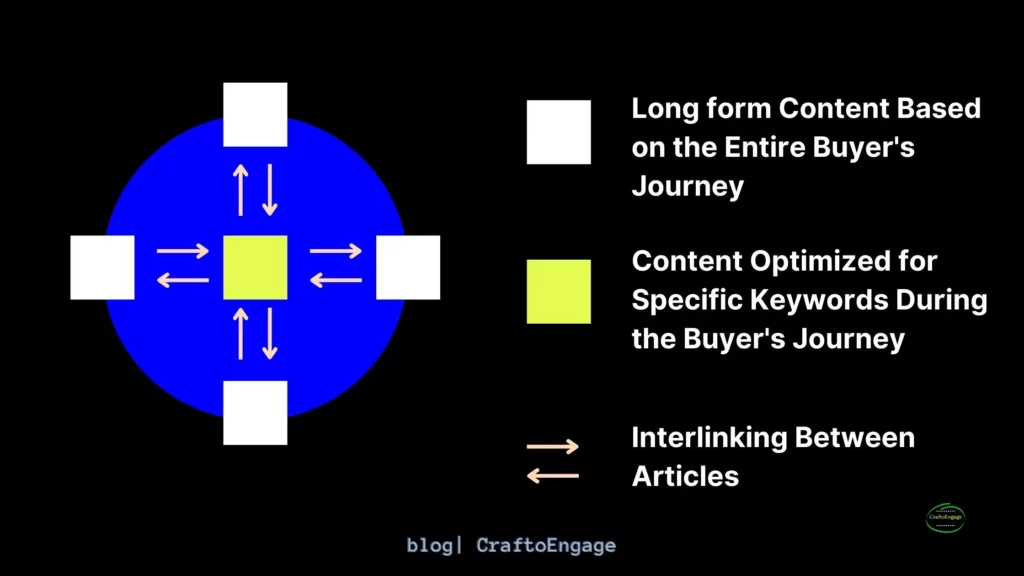
Why is Structured Content with Keyword Clusters Important
Here are 3 reasons why structuring your content with keyword clusters is so effective:
1. They Leverage Through Synergies Between Long-form and Short-form Content
A specific level article that has been optimized for long-tail keywords, ranks quicker relative to a long-form article. By putting a link out from your specific level article, you start to trickle out traffic to the long-form article, thus aiding it to rank faster. Once the long-form article starts ranking, the large volumes that it generates, trickles down to the specific level articles, thus creating a snowball effect.
2. They Improve Prospect Engagement Drastically
Some of your prospects are looking for short answers to their questions, while some are wanting to get a general overview. A cluster serves both purposes. Also, it routes your prospects from short-form to long-form through links that give your prospect a seamless reading experience. This improves engagement drastically.
3. They Take Prospects on their Buyer’s Journey
By smartly linking your content, you are nudging your prospect to go to the next-level information that they are going to need. Nothing delights the prospect more than them finding an answer to a question they haven’t even asked yet! Google views your article favorably when Google sees that you are proactively taking your prospects on their buyer’s journey.
Content Marketing SEO Strategy #4 – Create Multi Modal Content
Multi modal content is content that is in form of text, images, audio, and video. Text is the fastest to consume, so it is central in content optimization for Google searches. That said, video is dominating content in a big way. Hence, it makes sense to have your content as a video and embedded into your website content.
More and more people are now getting habituated to consuming content while they are on the move. It therefore makes sense to create audio content that they can consume while they are driving or exercising.
Images serve three broad purposes:
- They aid and enhance text content.
- Google is big on Image searches. In order to connect the right content to the right audience, google pays attention to the images in your content. Google will continue to invest in image recognition. (Google Lens is a prime example.)
- Decorative purpose. Enhancing visual appeal helps in outreach for your prospects.
Use Stock Images Mindfully
Refrain from using Stock Images excessively. This is because google would have probably noticed the same stock image from other sites. This will limit your way of standing out of the competition. However, note that google does not treat the use of stock images positively or negatively.
So, to summarize multi-modal content – You are catering content to your prospects in modes that are convenient to them. When you offer these modal choices, dwell time will increase, i.e., people will stay on your content longer. Google watches these user engagements and favors them in its ranking. A high dwell time is an indication that the searcher is getting the information that they are searching for.
This simple content marketing SEO strategy that offers a choice to your prospects to consume content in whatever communication mode they want is powerful indeed!
Strategy #5 – Refresh Your Content Periodically.
Google Web Crawlers know when you change content on your site. Refreshing your existing content is considered an effort to improve the quality of your content, which is favored.
Here are some specific actionables on how to refresh your existing content:
- Tweak some parts of your existing content, periodically.
- Explain things in a better way by adding schematics or fresh graphics.
- Introduce a practical case study or narrative to enhance an existing section or a specific point that is being made.
- While you are crafting new content, take the time to revisit your existing content and see if you can link out to your new content from this old. Internal links are a great way to keep dwell time on your domain high. Of course, link also from the new to the old.
- Keep adding more to your existing content in a way that doesn’t disturb the core structure of your blog article. If you think that the core structure of your content piece is going to change, then go with a new content piece.
Strategy #6 – Integrate Social Media with SEO Content Marketing
Social media platforms such as LinkedIn and Twitter still have good organic outreach. You can consider writing a brief, summarized article on LinkedIn and then linking that out to your content piece on your website. This will get you the initial trickle of good-quality traffic. Google sees this initial trickle and so starts to promote your article, which is good for your content marketing SEO.
You can do the same with other social media channels, notably :
- Answering questions on Quora related to this topic.
- Starting a Facebook group or a Facebook business page.
- Making a youtube short as a teaser.
- Longer form Youtube video.
- Make content on Pinterest, Instagram, and Tumblr.
In all the above content forms, link your social media content to your content piece on your website.
Again, as mentioned above, you will have good quality traffic tricking down to your content on your domain. In the case of Quora, if the answer to your question ranks at the top of all the other answers, then your Quora answer might also show up on the first page of the Google SERP. If that happens, you will experience a sudden boost in traffic.
Should I Hire an Agency for my Content Needs?
Content is a continuous and never-ending process. It never stops. Learning SEO concepts take time and experience. If you are serious about content marketing, hire the right people for this function. While hiring, make sure that the candidate has expertise in BOTH – Content Creation and SEO. You will be creating unnecessary silos if you hire separately for the Content Creation and SEO functions. Also note that with passing time, these silos are going to get more and more blurred. If you don’t want to take on the bother of hiring an in-house content creator, you can outsource your content work to an agency. This marketing agency must specialize in content and should be updated on the latest Google search engine algorithm changes.
Avoid hiring freelancers from popular freelancing platforms. While there is no doubt that you will get some great hires, you will take a hit on consistency. When you hire in-house or get the work done from a marketing agency, you end up paying a premium for consistency. And that’s worth it. A brand that stands out is, amongst other things, one that offers a consistent experience.
Conclusion
In this piece of content, we have discussed some Key Concepts related to content marketing SEO, and 6 Powerful Content Marketing SEO Strategies to help your content rank higher on Google Search Engines. Below is a quick summary:
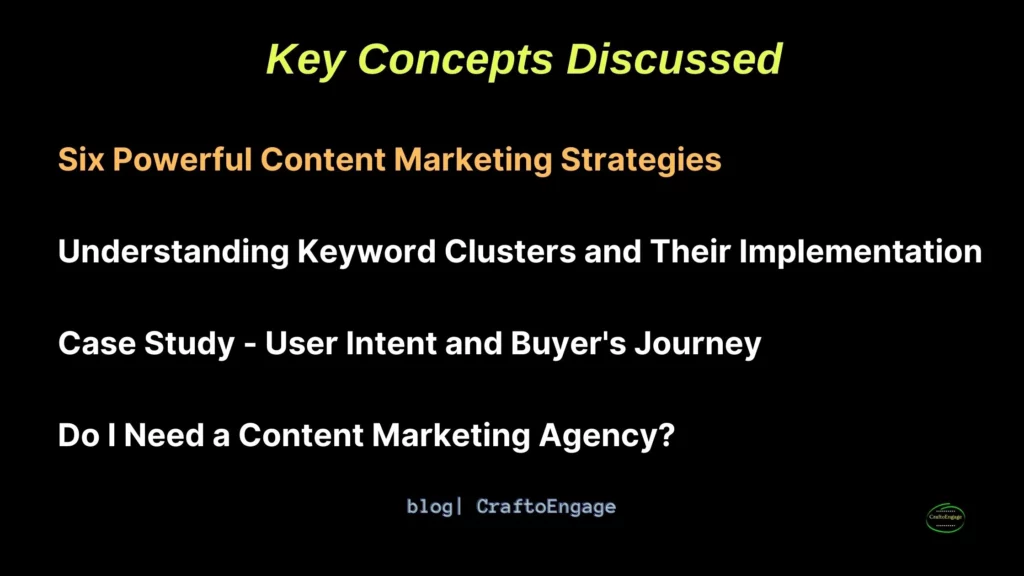
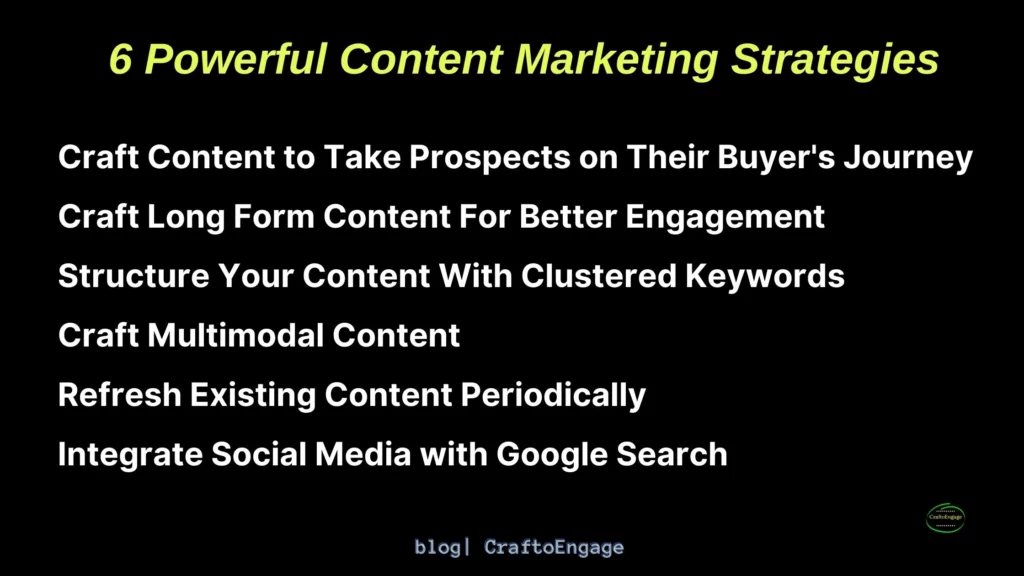
As Google algorithms become more and more understanding of human language, they will do better and better in finding the right information piece for the right audience. Keep this in mind as a content creator, and work on strategies that will help Google in finding your piece of content amongst others.
To conclude then, we have understood what content marketing SEO strategy is all about. We have discussed 6 of these in detail. So tell me, what combination of the 6 strategies that we discussed are you going to incorporate in your content pieces? And based upon your analysis, how is your content marketing SEO Strategy is going to shape out? Let me know in the comments below. Thanks for reading!
